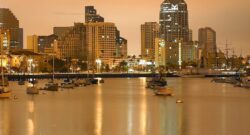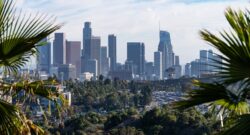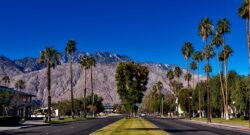Author: dailycastsocal
[2015] The Walking Dead Escape : FULL Course : Comic-Con (San Diego, CA)
2015 HD POV of the Entire Walking Dead Escape Obstacle course at San Diego Comic-Con in California. This year’s run included … source
Los Angeles Headlines
After assessing the devastation brought by the Mountain Fire in Ventura County, California Governor Gavin Newsom declared that he would sign an emergency declaration on Thursday to assist teams in extinguishing the flames. Fueled by strong Santa Ana winds, the wildfire, spanning nearly 21,000 acres, compelled thousands to evacuate their residences. It rapidly expanded by thousands of acres, leading to injuries and destruction of homes. Within five hours, the blaze escalated to over 10,000 acres and consumed an additional 4,000 acres by 7:30 p.m. on Wednesday, according to authorities. It ignited around 8:50 a.m. on South Mountain in the Moorpark vicinity, near the intersection of Balcom Canyon Road and Bradley Road, as reported by the California Department of Forestry and Fire Protection, or Cal Fire. As of Thursday night, Cal Fire officials noted that the wildfire had reached 20,485 acres, while containment efforts had brought the situation to 5% contained. “This occurred yesterday,” Newsom remarked while observing the remnants of a destroyed home. “It’s remarkable how rapidly this fire spread and how extensive it has become.” Mandatory evacuation orders were broadened overnight, with Santa Paula being the latest area where residents were required to leave, Ventura County Sheriff Jim Fryhoff stated at a Thursday morning press briefing. “We understand this is an agonizing time, and our thoughts are with each of you,” Fryhoff expressed to evacuees and those affected in the vicinity. “The fire peril remains extraordinarily high.” Residents in Camarillo, Somis, and Moorpark also faced evacuation as the conflagration intensified. A home ablaze during the Mountain Fire in Camarillo, California, on Wednesday, Nov. 6, 2024. The swiftly spreading Mountain Fire in Ventura County has engulfed 1,000 acres and is uncontained, prompting evacuations in densely populated areas northeast of Oxnard. Photographer: Eric Thayer/Bloomberg via Getty Images Bloomberg “We initially engaged in defending structures, ensuring life safety, and undertaking heroic measures across the incident,” Ventura County Fire Captain Trevor Johnson stated. Newsom mentioned that over 10,000 individuals were evacuated due to the fire threatening approximately 3,500 homes, businesses, and other infrastructures. The Federal Emergency Management Agency allocated funding to support firefighting efforts, as stated by Newsom. Authorities reported that at least 14,000 individuals had been instructed to evacuate, according to Fryhoff. The fire progressed southwestward from Wednesday into Thursday, with helicopters continuously conducting water drops throughout the night, Johnson described, noting this was “unusual for any wildland incident.” “Our current focus is on the northeast flank of the fire, situated north of Somis and south of Santa Paula in the Santa Susana Mountain range,” Johnson said. “That area poses challenges due to its rugged, steep terrain, accessible only by our most skilled firefighters.” Multiple environmental factors converged to ignite the blaze and propel it across thousands of acres, including the accumulation of dry brush from exceptionally wet periods in the area, combined with the forceful Santa Ana winds, according to Drew Smith, a fire behavior analyst with the Los Angeles County Fire Department. “We are emerging from two years of above-average precipitation, which created a very lush grass component,” Smith explained. “The presence of these fine fuels, which readily ignite in warm, dry, windy conditions, fosters significant fire growth when high winds are present.” “When these environmental factors align, it results in a combustible fuel bed,” he added, noting strong winds can spread embers up to three miles, facilitating “significant fire escalation.” Homes lost, injuries reported as residents evacuate Ventura County officials reported that 10 individuals suffered injuries, primarily due to smoke inhalation. During an overnight shelter stay in Camarillo, American Red Cross spokesman David Wagner indicated that nurses treated minor injuries like scrapes and burns that people sustained while escaping the fires. The shelter offered families beds and meals during the evacuation period. Damage assessment teams continued to evaluate the destruction on Thursday to ascertain the extent of the damage. As of Thursday evening, they reported 132 buildings destroyed and 88 more damaged. Several evacuees recounted their experiences of helping friends, family, and neighbors escape the advancing fire as it ravaged areas of Camarillo, Moorpark, and Somis. Dozens of schools announced closures, thousands encountered power shutoffs, and the city of Ventura asked residents to conserve water so sufficient resources were available for firefighting efforts. CAMARILLO, CALIFORNIA – NOVEMBER 07: A homeowner surveys the wreckage of their property that was consumed by the Mountain Fire still raging on Nov. 7, 2024, in Camarillo, California. The fire, fueled by powerful winds, has scorched over 14,000 acres and obliterated numerous residences since its onset a day earlier. Getty Images Approximately 2,200 firefighters are responding, prioritizing life-saving actions, according to authorities. “Our primary focus at Ventura County Fire, while managing this incident, is life safety,” firefighter and Ventura County Fire spokesperson Andrew Dowd stated on Wednesday. “We implore all residents in the affected zones to adhere to evacuation orders. Ensuring safety is our topmost priority.” Wind gusts in the Mountain Fire region reached 39 mph in Moorpark and Simi Valley Thursday morning, with a high wind advisory anticipated to last until 4 p.m., after which winds are expected to diminish to about 15 mph. Evacuation mandates The Ventura County Sheriff’s Office has instituted evacuation orders affecting thousands of residents in Camarillo, Somis, and near the Santa Clara River. As the fire continued its southward trajectory Thursday morning, evacuation orders were enacted in the Camarillo vicinity, including near the Las Posas Country Club and Sterling Hills Golf Club, due to the fire’s direction. “All evacuation orders and alerts remain active due to the extreme fire risk,” officials stated in a Thursday morning update. A real-time evacuation order map is available here. “If you’re in the vicinity of the fire, and you detect smoke, you should be ready to leave,” Ventura County Fire Chief Dustin Gardner warned. He also cautioned against attempting to stay behind to protect properties. “This happens repeatedly. Individuals often aim to stay and safeguard their homes right until the flames reach their properties,” Gardner stated. “Once the fire arrives, it becomes perilous, smoky, and visibility is compromised, making it impossible to defend your home. Don’t risk it… Your material possessions can be replaced, but your loved ones cannot.” Authorities established an evacuation center at Padre Serra Parish, located at 5205 Upland Road in Camarillo. Residents with larger pets were directed to the Ventura County Fairgrounds, located at 10 E. Harbor Boulevard, whereas smaller pets can be brought to the Ventura County Animal Shelter near Camarillo Airport, at 600 Aviation Drive. As of Thursday, road closures were in effect at the following locations: Northbound Lewis Road at Las Posas Eastbound Highway 118 at Wells Road Westbound Highway 118 at Tierra Rejada Road School closures Numerous schools in Ventura County closed due to the Mountain Fire, with some campuses shutting down due to poor air quality stemming from the large wildfire, and others due to power shutoffs implemented by utility companies to mitigate further fire risks. Certain schools have adopted measures such as keeping students indoors at those that remain operational, amid widespread smoke and ash in the atmosphere. “Our hearts ache for the families in Camarillo who have been displaced,” stated the Pleasant Valley School District during their closure announcement. “We recognize that our students have been impacted by today’s events. Upon resuming classes, all schools will incorporate plans to address the mental health needs of our students.” A comprehensive list of school closures can be found here. Intense Santa Ana winds intensify flames The fire occurs amid severe winds impacting much of Southern California, prompting National Weather Service officials to issue Red Flag Warnings. In this case, they declared a “Particularly Dangerous Situation” advisory, a unique weather alert rarely issued due to exceptionally grave conditions. Meteorologists observed gusts surpassing 60 mph as the fire roared Wednesday. Winds calmed on Thursday, with gusts anticipated to be around 30 mph until noon, after which they are expected to decrease further. Rich Thompson, an incident meteorologist with the National Weather Service, noted that some of the extreme Red Flag conditions had lessened by Thursday, though Santa Ana winds may still gust from the northeast at approximately 25 to 35 mph in the afternoon. “This morning, conditions have improved somewhat, so now we only have a standard Red Flag warning active for the area,” Thompson noted, adding that significantly low humidity would persist throughout the day while winds would taper off later into the afternoon. The intense winds grounded firefighting fixed-wing aircraft within the first hours of the wildfire, complicating containment efforts, fire officials indicated. Dr. Josh Fisher, a climate scientist at Chapman University, stated that various factors converged, causing the wildfire to advance rapidly across hillsides and neighborhoods in Ventura County. “Fire spreads more quickly upwards, ” Fisher explained. “We have the combination of topography, wind, and plant conditions — coupled with proximity to roads and residences — all contributing to a situation far worse than it could have been if wind conditions were calm and vegetation was moist.” Authorities are still investigating the cause of the fire. Community response As the situation evolved with flames devastating vast tracts of land within hours, residents were compelled to act quickly to evacuate their homes. “We’ve never experienced anything like this. We never anticipated such an event,” commented Ken Levin, a resident near the Spanish Hills area. “However, the fire department is on-site, constructing fire breaks on our property, and the winds are mostly southward. We feel optimistic about our situation… I think we will be alright.” “I am grateful for the firefighters who are here for us in our hour of need,” he added. In Camarillo, a woman rushing to assist her friend with their evacuation shared her harrowing experience. “She was extremely shaken and unable to clearly communicate what to take, and I felt rattled too,” Cindi Hitt described. “Eventually, I recognized I had to leave. It was time to exit.” However, Hitt faced close calls during her attempted escape, getting her car stuck just as she tried to flee. “My vehicle got trapped just a few feet from the flames,” she recalled. “Thankfully, the firefighters were right there, and they were incredibly supportive.” With their help, Hitt was able to get her vehicle unstuck, enabling her and her friend to escape. She urged others in the vicinity to leave immediately. “It was terrifying. My only advice is… Do not delay,” Hitt stressed. More from CBS News Marissa Wenzke Marissa Wenzke is a journalist based in Los Angeles. She has a bachelor’s degree in political science from UC Santa Barbara and is a graduate of Columbia Journalism School. Source link
San Diego News Update
Source: The Associated Press provides the election results and race calls. The Times generates its own estimates regarding each candidate’s share of the final vote and the number of outstanding votes, utilizing historical turnout data and information from results providers. Please note that these figures are estimates and may not reflect reports from election officials. Contributors from The New York Times election results team: Michael Andre, Emma Baker, Neil Berg, Andrew Chavez, Michael Beswetherick, Matthew Bloch, Lily Boyce, Irineo Cabreros, Nico Chilla, Nate Cohn, Alastair Coote, Annie Daniel, Saurabh Datar, Leo Dominguez, Tiff Fehr, Andrew Fischer, Martín González Gómez, Will Houp, Jon Huang, Junghye Kim, K.K. Rebecca Lai, Jasmine C. Lee, Joey K. Lee, Vivian Li, Alex Lemonides, Ilana Marcus, Alicia Parlapiano, Jaymin Patel, Dan Simmons-Ritchie, Charlie Smart, Jonah Smith, Urvashi Uberoy, Isaac White, and Christine Zhang Additional contributions by Grace Ashford, Luke Broadwater, Mathew Brownstein, Amanda Cordero, Kenan Davis, Karoun Demirjian, Robert Draper, Catie Edmondson, Nick Fandos, Lalena Fisher, Patrick Hays, Robert Jimison, Annie Karni, Maya Miller, Julie Walton Shaver, Tracey Tully, Lisa Waananen Jones, and Jessica White Edited by Wilson Andrews, Lindsey Rogers Cook, William P. Davis, Thomas Gaffney, Amy Hughes, Ben Koski, Allison McCartney, and Rachel Shorey Source: The Associated Press provides the election results and race calls. The Times generates its own estimates regarding each candidate’s share of the final vote and the number of outstanding votes, utilizing historical turnout data and information from results providers. Please note that these figures are estimates and may not reflect reports from election officials. Source link
360° Video | We stop by the Queen Mary | Long Beach California
We stopped in Long Beach for a minute on the way to Santa Anna. I wish I could have got on the boat but it was too expensive. source
More Traveler’s Secrets When Visiting San Diego
Exploring Balboa Park: A Cultural Treasure Trove with Free Admission Days San Diego, California, is known for its stunning beaches, vibrant neighborhoods, and unmatched climate, but few destinations capture the heart of the city quite like Balboa Park. Home to an impressive array of museums, gardens, and green spaces, Balboa Park is a cultural oasis, offering visitors a unique opportunity to explore art, science, and history—all amidst the park’s beautiful architecture and landscapes. One of the park’s most appealing features is its commitment to accessibility. Many museums within Balboa Park offer free admission on select Tuesdays, allowing both locals and visitors to delve into the rich offerings of San Diego’s cultural scene without breaking the bank. In this article, we highlight the benefits of visiting Balboa Park on these special days, alongside tips for making the most of your experience. The Museums of Balboa Park Balboa Park houses 17 museums, each with its own unique focus and exhibits. Some of the most popular include: San Diego Museum of Art – Featuring a diverse collection of European, American, and Asian art, this museum is a paradise for art lovers. San Diego Natural History Museum – Ideal for families, this museum boasts fascinating exhibits on the natural world, including dinosaurs and local wildlife. Reuben H. Fleet Science Center – With hands-on science exhibits, an IMAX theater, and live demonstrations, this museum offers an interactive experience for all ages. Museum of Photographic Arts – Showcasing photography in all its forms, this museum highlights the significance and evolution of visual storytelling. Other notable museums include the San Diego Air & Space Museum, the San Diego History Center, and the Timken Museum of Art. To take full advantage of these institutions, check their schedules for free admission days. Free Admission Days Typically, many of Balboa Park’s museums participate in free admission initiatives on the first Tuesday of each month, but this can vary. Some museums may also offer free admission on special occasions, such as holidays or anniversaries. It’s essential to check ahead on each museum’s official website for the most accurate and up-to-date information regarding free admission days, hours of operation, and any special exhibits that may require a fee. Tips for Planning Your Visit Arrive Early: Free admission days often attract larger crowds, so arriving early can help you avoid long lines and secure your spot at popular exhibits. Combine Museums: With multiple museums participating in free days, plan your itinerary to visit several in one day. Take advantage of the designated walking paths and public transportation within the park. Explore the Gardens: Balboa Park is not just home to museums; its gardens are equally spectacular. Be sure to visit favorites like the Botanical Building and the Japanese Friendship Garden, which are great ways to complement your museum visits. Pack a Picnic: Enjoy a meal outdoors by bringing a picnic. Balboa Park offers numerous scenic spots to relax and savor your food amidst the beautiful surroundings. Prepare for Parking: Parking can be challenging on busy days, so consider utilizing public transportation or ride-share services. Alternatively, arrive early to secure parking in one of the park’s lots. Stay Informed: Alongside checking museum admission schedules, subscribe to Balboa Park’s newsletter or follow them on social media for updates on special events, free days, and educational programs. The Cultural Benefits of Visiting Taking advantage of free admission days is not just cost-effective; it’s also a fantastic way to immerse yourself in the local culture. Balboa Park beautifully encapsulates San Diego’s artistic diversity and serves as a platform for educational outreach and community engagement. Families, students, and tourists alike will find something of interest, inspiring curiosity and a deeper understanding of art, science, and history. Conclusion Balboa Park stands out as a cultural gem in San Diego, offering something for everyone. By planning your visit around the fantastic free admission opportunities available on select days, you’ll be able to explore the park’s numerous museums and attractions without the financial strain. So grab your calendar, check ahead, and prepare for a day of discovery in one of the most beautiful parks in the country!
More Insider’s Secrets When Visiting Los Angeles
Discover Los Angeles: Enjoying the City During Less Crowded Times Los Angeles is a city known for its sun-soaked beaches, iconic landmarks, and vibrant culture. However, with its popularity comes large crowds, making it sometimes challenging to fully embrace everything it has to offer. One effective strategy to navigate the bustling atmosphere of LA is to visit attractions during off-peak hours—especially early in the morning or late in the evening. This article explores the benefits of these less crowded times for an unforgettable experience while taking in the stars of this dazzling city. Morning Magic: Rise with the Sun Imagine starting your day before the city wakes up. The soft glow of dawn paints the horizon with pastel hues as you explore Los Angeles in tranquility. Visiting popular spots early in the morning allows you to savor the beauty of renowned locations without the usual throngs of tourists. Here are a few suggestions: Griffith Observatory: Arriving at Griffith Observatory around sunrise offers stunning views of the city below—especially when the early morning fog rolls in. Not only will you avoid crowds, but you’ll also have an unmatched opportunity to snap breathtaking photographs of the observatory against the backdrop of a colorful sky. Santa Monica Pier: The iconic Santa Monica Pier is a must-see, but it’s often bustling throughout the day. Visiting just as the sun rises provides a serene environment to walk along the beach, snap some photos of the pier bathed in morning light, and maybe even catch a glimpse of dolphins frolicking in the ocean. Hollywood Walk of Fame: The stars embedded in the sidewalks of Hollywood Boulevard are a significant draw for visitors. Arriving early means you can enjoy this famous stretch before it fills up, allowing for easy photography without tourists stepping into your frame. Evening Enchantment: Embrace the Night As the sun sets and the city lights begin to twinkle, Los Angeles takes on a magic of its own. Evening visits can create a completely different atmosphere, offering unique photo opportunities and a chance to experience the city’s vibrant nightlife. Some top evening spots include: The Getty Center: This incredible art museum offers stunning architecture and breathtaking gardens. Visiting in the late afternoon allows you to enjoy the surroundings while witnessing the sunset, with the golden hour bathing the museum in beautiful light. The views of Los Angeles as it transitions from day to night are nothing short of spectacular. Runyon Canyon: An evening hike in Runyon Canyon can offer some of the best views of the sunset against the city skyline. The trail is less crowded at this time, allowing for a peaceful hike followed by an Instagram-worthy view of the sun dipping below the horizon, illuminating the night. Griffith Park: A late-night walk around Griffith Park can be magical. The park often quiets down after sunset, providing a perfect setting for stargazing or capturing photos of the city’s skyline lit against the night sky. The Griffith Observatory’s public telescopes remain open until 10 PM, allowing visitors a chance to stargaze while avoiding the crowds. Photography Focus: Capturing the Stars Less crowded times offer not only a more enjoyable experience but also create perfect conditions for photography. The softer morning light or the dramatic contrast of city lights against the dark night sky can lead to stunning images. Here are a few tips for capturing great photos during your visits: Golden Hour: Plan your visits around the golden hour—early mornings or late afternoons. This is when natural light is best for photography. Use Tripods: If you’re aiming to shoot in lower light conditions, a tripod can help you stabilize your camera for clearer images. Explore Angles: With fewer people around, you have the freedom to explore various angles and compositions without worrying about interruptions. Night Photography: Experiment with long exposure shots in the evening to capture the movement of lights and stars. Final Thoughts Visiting Los Angeles during less crowded times, particularly early mornings and late evenings, can elevate your experience from simply seeing the sights to genuinely enjoying the city’s ambiance. Not only will you witness breathtaking views and photograph iconic landmarks, but you’ll also soak in the serenity that comes with fewer people around. Whether you’re an avid photographer or simply want to revel in the beauty of LA, embracing these quieter hours is a surefire way to create lasting memories in the City of Angels. Plan your trip accordingly, and immerse yourself in the best of what Los Angeles has to offer!
More Amazing Things To Do In Palm Springs
Discover the Desert Beauty: Canyon Tours in Palm Springs Nestled in the heart of California’s Coachella Valley, Palm Springs is a vibrant oasis known for its stunning desert landscapes, luxurious resorts, and rich cultural heritage. One of the best ways to immerse yourself in the area’s natural beauty is by exploring the breathtaking hiking trails at Palm Canyon and Andreas Canyon. This article is part of an ongoing series that offers tips and suggestions for visitors looking to experience the best of what Palm Springs has to offer. Palm Canyon: A Hiker’s Paradise Palm Canyon, located within the Agua Caliente Band of Cahuilla Indians Reservation, is a spectacular destination for those seeking an unforgettable hiking experience. The canyon features lush palm oases, towering cliffs, and vibrant desert flora that create an enchanting environment that feels worlds away from the bustling city. Trail Highlights: The Palm Canyon Trail: This moderate-easy trail is about 3 miles long and meanders through a magnificent grove of California Fan Palms, providing ample opportunities for photography and wildlife observation. As you hike, you’ll witness the striking contrasts between the verdant palm fronds and the stark, rocky landscape that surrounds them. Don’t forget to pack your camera! The Tachevah Trail: For those looking for a more challenging hike, Tachevah Trail offers steeper inclines with rewarding views of the canyon below. This trail also leads to panoramic vistas that stretch across the Coachella Valley, showcasing the desert’s raw beauty. Make sure to bring plenty of water and wear sturdy shoes! Andreas Canyon: Majestic Scenery Awaits Just a stone’s throw away from Palm Canyon, Andreas Canyon presents another opportunity for hikers to connect with nature. This area is particularly known for its stunning rock formations, diverse vegetation, and the serene sound of water flowing in the nearby creek. Trail Highlights: The Andreas Canyon Trail: This 1.5-mile loop is perfect for families and novice hikers. The trail meanders through a magical landscape dotted with towering palm trees, vibrant wildflowers, and unique rock structures. Along the way, visitors can find shaded spots to rest and take in the tranquil surroundings. Birdwatching and Wildlife Viewing: Andreas Canyon is a haven for birdwatchers, with dozens of species drawn to its rich ecosystem. Bring binoculars and take a moment to enjoy the sights and sounds of the desert’s feathered residents. Tips for a Successful Canyon Adventure Stay Hydrated: The desert’s arid climate can take a toll even on experienced hikers. Carry plenty of water and snacks to keep your energy levels up during your hike. Sun Protection: With the sun shining brightly in Palm Springs, don’t forget to bring sunscreen, sunglasses, and a hat to protect yourself from harmful UV rays. Footwear: Proper footwear is essential when hiking in the desert. Opt for sturdy hiking boots or shoes for optimal support and traction on rocky terrain. Timing: Early mornings or late afternoons are the best times to hike to avoid the peak heat of the day. Additionally, the lighting during these hours offers the most stunning views and photo opportunities. Leave No Trace: As you explore these beautiful canyons, remember to respect the ecosystem. Stay on marked trails, pack out what you pack in, and avoid disturbing wildlife. Conclusion Exploring Palm Canyon and Andreas Canyon offers a remarkable opportunity to experience the natural beauty of California’s desert landscape. Whether you’re an experienced hiker or just taking a leisurely stroll with family, these canyons provide an enriching experience that’s sure to leave you with lasting memories. As part of your Palm Springs adventure, don’t miss out on these stunning hikes—each step brings you closer to understanding and appreciating the desert’s enchanting allure. Stay tuned for more tips and destinations in our ongoing series to help you make the most of your visit to this desert gem!


![[2015] The Walking Dead Escape : FULL Course : Comic-Con (San Diego, CA) [2015] The Walking Dead Escape : FULL Course : Comic-Con (San Diego, CA)](https://wp.fifu.app/socal.dailycast.news/aHR0cHM6Ly9pLnl0aW1nLmNvbS92aS9RZ3k1Y3FtWEN0VS9ocWRlZmF1bHQuanBn/88dfca5e27ed/2015-the-walking-dead-escape-full-course-comic-con-san-diego-ca.webp?w=250&h=135&c=1&p=100000578)





